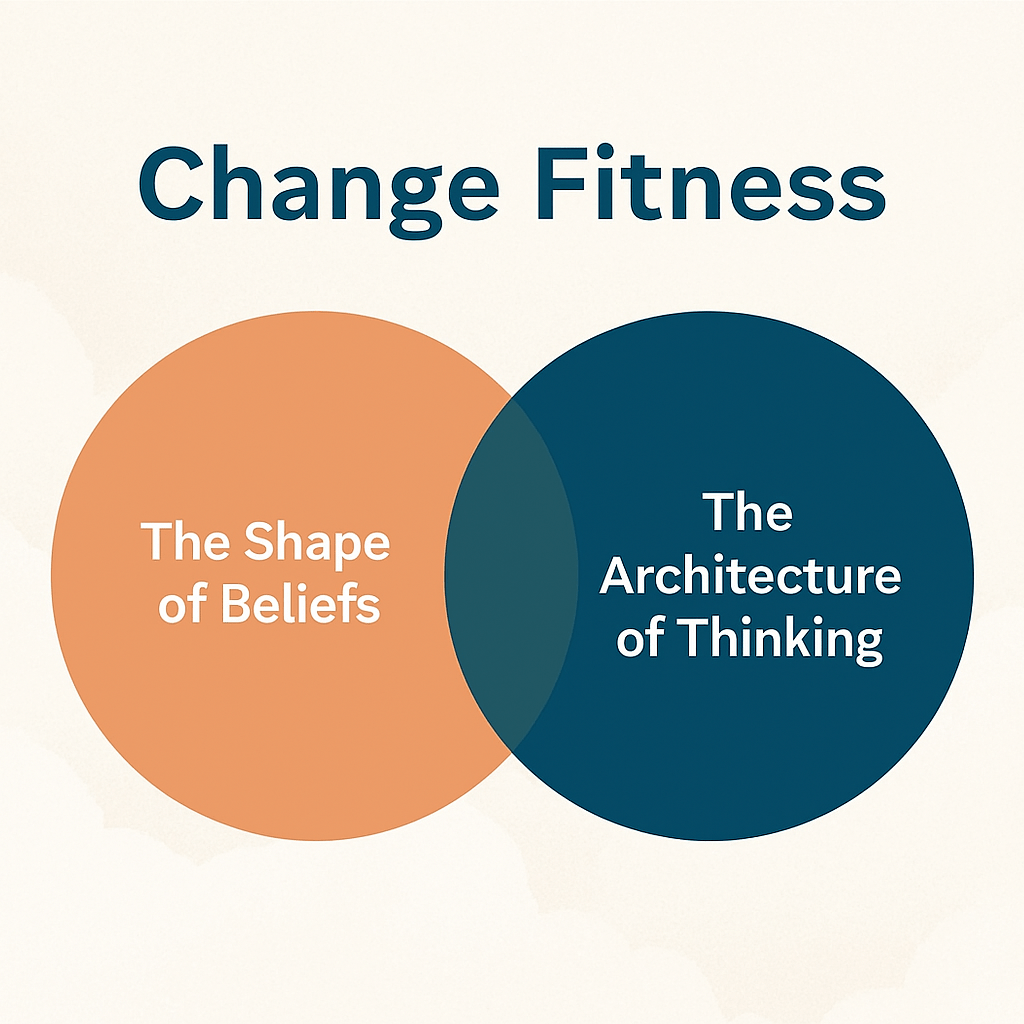Change Fitness: The Hidden Capability for Thriving in Uncertainty
Introduction
Most organisations talk about “managing change.” Fewer talk about fitness for change—the deeper capability that determines whether people can adapt, sustain, and grow through disruption.
Change fitness is not about tools, templates, or project plans. It is about people—their beliefs, their thinking, and their capacity to learn new ways of engaging with complexity. Two elements are especially important:
The shape of the beliefs people hold about themselves, others, their context, and their world.
The architecture of their thinking—not just what they think, but how they think, and how they learn to think differently.
When these two elements are strong, organisations can face uncertainty with confidence. When they are weak, even the best strategies falter.
Beliefs: The Shape of How We See the World
Beliefs act like lenses. They shape how people interpret events, how they respond to challenges, and how they relate to others. In the context of change, four domains of belief are especially influential:
Beliefs about Self: Do I see myself as capable of adapting, or do I assume I will fail?
Beliefs about Others: Do I trust my colleagues and leaders, or do I expect resistance and conflict?
Beliefs about Context: Do I view my environment as supportive and full of opportunity, or as hostile and limiting?
Beliefs about the World: Do I see change as a natural part of life, or as a threat to stability?
Example: A Team in Transition
Imagine a team asked to adopt a new digital platform. Two staff members approach it differently:
One believes, “I’m not good with technology; I’ll never get this right.” Their self-belief limits their engagement.
Another believes, “I’ve learned new systems before; I can figure this out.” Their belief opens the door to learning.
The difference is not in technical skill—it’s in the shape of their beliefs. Change fitness begins with reshaping these beliefs so that people see themselves and their context as capable of growth.
Thinking: The Architecture Behind the Beliefs
If beliefs are the lenses, thinking is the architecture that holds them in place. Change fitness is not only about what people think, but how they think.
Do they think in rigid categories, or can they hold multiple perspectives at once?
Do they look for quick fixes, or can they tolerate ambiguity long enough to find deeper solutions?
Do they repeat old patterns, or can they learn to think differently when the situation demands it?
This is the architecture of thinking—the scaffolding that supports (or constrains) adaptive behaviour.

Example: Problem-Solving in Healthcare
A hospital faces rising patient demand. One group of leaders frames the problem narrowly: “We need more beds.” Another group thinks differently: “What if we redesigned patient flow to reduce bottlenecks?”
Both groups are responding to the same challenge, but their thinking architecture is different. One is linear and reactive; the other is systemic and adaptive. The second group is demonstrating higher change fitness—not because they know more facts, but because they can think differently.
Learning to Think Differently
The most powerful aspect of change fitness is that it can be developed. People are not locked into their current beliefs or thinking patterns. With the right conditions, they can learn to:
Surface and question assumptions they didn’t even realise they held.
Experiment with new perspectives, testing different ways of framing problems.
Stretch their thinking architecture, moving from rigid patterns to more flexible, adaptive ones.
This is not about teaching people what to think. It is about equipping them to learn how to think differently—a capability that compounds over time.
Example: Community Engagement
In a community health project, practitioners initially framed low participation as “lack of interest.” By learning to think differently, they reframed it as “lack of trust.” This shift in thinking architecture opened new strategies—building relationships first, then introducing programs. Participation rose dramatically.
The key was not more information, but a new way of thinking.
Why Change Fitness Matters
Organisations often invest in change management as if it were a technical exercise. But without change fitness, those investments are fragile.
A new system will fail if people believe they cannot master it.
A new strategy will stall if leaders cannot think beyond old categories.
A new culture will not take root if people cannot learn to think differently about themselves and others.
Change fitness is the foundation. It is what allows people to engage with change not as a threat, but as an opportunity for growth.
Building Change Fitness Without Giving Too Much Away
While the detailed methods for building change fitness are proprietary, the principles are clear:
Start with beliefs: Help people see themselves and their context as capable of growth.
Strengthen thinking architecture: Equip people to think in more flexible, systemic, and adaptive ways.
Create learning environments: Give people safe spaces to experiment with new ways of thinking and relating.
These are not one-off interventions. They are ongoing practices that, over time, build the fitness to thrive in uncertainty.
Conclusion
Change fitness is not about managing projects—it is about preparing people. It involves reshaping the beliefs that guide how people see themselves, others, and their world. And it involves strengthening the architecture of their thinking, so they can not only think differently, but learn how to think differently.
In a world where disruption is constant, change fitness is the hidden capability that turns uncertainty into opportunity. Organisations that invest in it are not just managing change—they are building the fitness to thrive.
